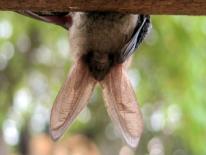
The District’s bats are in trouble. By learning to live with bats you can help with their long-term conservation.
Bats are one of the most mysterious and least understood groups of mammals.
The District is home to seven bat species. Two are listed as either threatened or endangered. Below you’ll find the answers to the frequently asked questions about why bats are in trouble, how to safely live with them, and what you can do to help.
Bats are the only mammals that can fly. Some of the District’s tree bat species migrate long distances from summer roosts to their wintering grounds, while our cave bat species fly to the caves and mines of other states to hibernate. In their travels, they have been known to fly over land, along coastlines and over water much like migrating birds. Each spring, our bats return and grow strong after the long drain of winter by feasting on the District’s insects.
Bats provide a valuable and naturally organic service to people - we do not miss the mosquitoes, beetles, moths, and crop pests that bats eat! In fact, to gain the energy needed to nurse their young, female bats can eat the equivalent of their body weight in insects each night. Having a lifespan of 5 to 20 years and raising only one pup per summer (some species have twins), bats are loyal and will return to the same roost every year.
To report a bat colony or learn more about the District’s bats call/email:
Marco Carvello - Fish & Wildlife Biologist
(202) 731-6191 | [email protected]
Discover the bats of the District; the species we have, how to attract or safely evict them, get information about White-Nose Syndrome, find out what the state is doing for bats, and how you can help!

